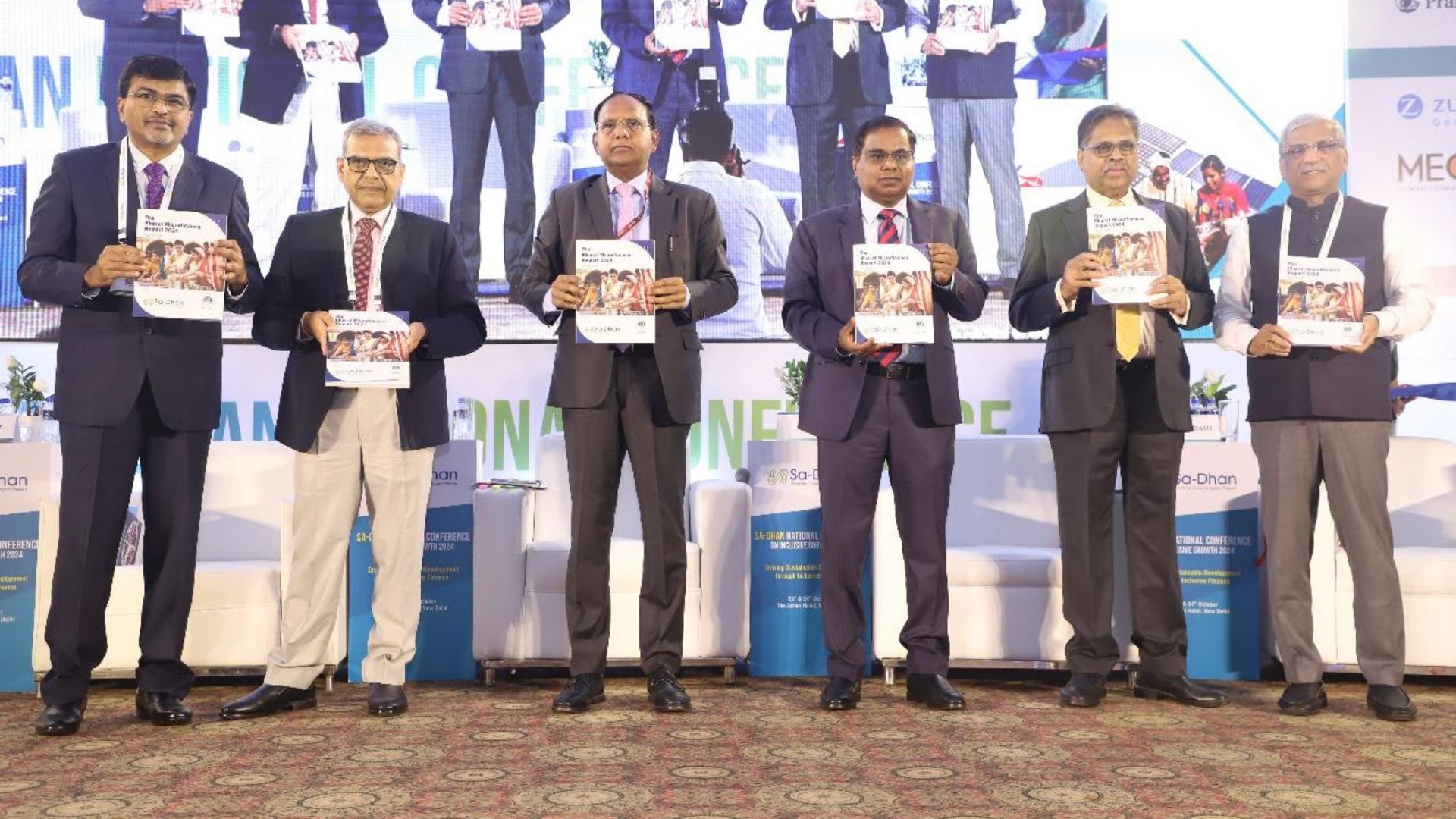
Microfinance Sector Urged to Ensure Sustainable, Inclusive Growth: Sa-dhan
The combined loan outstanding of the micro-finance sector stood at ₹ 4,42,700 crore as on 31st March, 2024 and with the sector registering a rapid growth, even more than the banking industry, there has been a need to ensure sustainable and inclusive ways of micro-financing and also to enhance the income levels of the beneficiaries, opined Shri M Nagaraju, Secretary, DFS, Ministry of Finance, Government of India while inaugurating the 19th Sa-dhan National Conference on Inclusive Growth 2024 organised by Sa-dhan in New Delhi today.
He lauded the role played by the Micro-finance Institutions including SHG bank linkage programme in reaching the unreached and providing them credit. However, he said that the micro-finance institutions needed to focus on the enterprise development and income generation of the poor.
Echoing a similar sentiment, the ‘Bharat Microfinance Report’ released by Sa-dhan during the Conference observed that the micro-finance institutions, particularly the ‘For – Profit’ organisations like NBFC-MFIs, NBFCs and SFBs should follow more caution for ensuring a better quality of assets and growth while exploring the ways of sustainable inclusive finance.
Shri Jiji Mammen, Executive Director and CEO of Sa-dhan said, “The micro-finance sector needs to move into a sustainable mode; so as to bring a comprehensive and sustainable development at the bottom of the pyramid. Micro-finance helps millions of poor people to access credit for their various needs, especially for their economic activities, with minimum hassles and an affordable cost. The Bharat Microfinance Report will help in give a new direction for the inclusive agenda by making available credit to the bottom of the pyramid.”
The Report highlighted that the combined loan outstanding of India’s growing microfinance sector stood at ₹ 4,42,700 crore, as outstanding against 1,613 lakh loan accounts, as on 31 March 2024 while the share of different institutions in loan outstanding stood as: NBFC-MFIs: ₹1,73,504 crore (39%); Banks: ₹1,46,909 crore (33%); SFBs: ₹74,712 crore (17%); NBFCs: ₹45,236 crore (10%) and Non-profit MFIs: ₹2,338 crore (1%).
In terms of growth, the total of 33,644 branch network of micro-finance institutions, including NBFCs and BC companies in the country, reached out to over 6,98,000 active micro clients with a total loan outstanding of ₹2,61,239 crore; including a managed portfolio of ₹79,410 crore.
Sa-dhan’s BMR report is based on the detailed analysis of various parameters is based on the information directly sourced from 217 Micro Lending Institutions (MLIs) which represented more than 98% MLI business in the country and also the data sourced the Credit Bureau.
Geographically, the top five states viz. Bihar, Tamil Nadu, Uttar Pradesh, Karnataka and West Bengal contributed 56% to the industry portfolio with Bihar alone accounting for nearly 15% of the total portfolio. The Southern region continued to have the upper hand in the share of loans outstanding, followed by the Eastern region. The proportion of rural clientele was 77% in FY 2023-24 and the women borrowers constituted 99% of the total clientele.
The Report also marked that a reduction of interest rates from 20% per annum to 19.5% per annum will not make a difference in the weekly or monthly installment payment of the poor household. Sa-dhan has also contributed significantly in creating awareness in the financial literacy space where it supported DEA workshops.
Sa-dhan’s Conference themed “Driving Sustainable Development through Inclusive Finance’ has brought together leading figures from government, banking, and the microfinance sector to deliberate through 13 sessions on various sustainable and inclusive growth agenda topics with 78 speakers participating in the discussions.
Shri M Nagaraju, IAS, Secretary, DFS, Ministry of Finance delivered the keynote address while other key speakers addressed the august gathering were Shri Shaji KV, Chairman, NABARD; Shri Manoj Mittal, CMD, SIDBI; and Shri Jayant Kr Dash, ED, Reserve Bank of India and Shri Paul Thomas, MD & CEO, ESAF Small Finance Bank. Other speakers will include Dr. Sourabh Garg, IAS, Secretary, MoSPI, Government of India; Mr. Shailesh K Singh, IAS, Secretary, Rural Development;
The Conference also released the SIDBI – Sa-dhan Report on Bridging the Gap – Microfinance as a Tool for Financial Inclusion in Under-served Regions.
Shri K V Shaji, Chairman, NABARD said, “Micro-finance is critical to India’s socio-economic development as it promotes financial inclusion and empowers the most vulnerable members of society. As over – indebtedness is a concern, we need to focus on improving the incomes of target beneficiaries. The SHG Bank Linkage programme and the JLG financing model, the two models practiced in the country, have a combined outstanding portfolio of over ₹ 7 lakh crore in micro-finance loans.”
Shri Jayant Kumar Dash, Executive Director, RBI opined that the magnitude of micro-finance depended on financial stability and sustainable development in the wake of increasing credit gap. He also opined that the micro-finance institutions should focus on multiple financial products including financial literacy for the well- being of the poor.
Shri Manoj Kumar Mittal, Chairman and Managing Director, SIDBI said, “A major criteria of Viksit Bharat for 2047 is to have enlarged incomes of households. We need to look at every component of costs to beneficiary in the wake of increasing outstanding loans where sustainable financing will play a major role. He raised a question as to whether the micro-finance institutions can give a better price to the borrowers by improving the operational efficiency.” Shri K Paul Thomas, Chair-person, Sa-dhan observed that the Indian MFIs had brought a banking revolution.




Leave a Reply